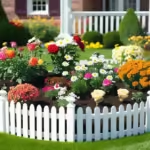River rocks are smooth, polished stones naturally shaped by water currents. These stones, varying in size, color, and texture, are not only durable but also versatile, making them an excellent choice for landscaping. Whether you’re looking to add a decorative touch or improve the functionality of your outdoor space, river rocks offer endless possibilities.
In this guide, we’ll dive deep into 13 river rock landscaping ideas, providing step-by-step instructions, tips, and inspiration. Additionally, we’ll cover FAQs and maintenance advice to help you maximize the benefits of using river rocks in your landscape.
What Are River Rocks?
River rocks are natural stones shaped over time by the flow of water in rivers and streams. Available in a variety of sizes—from small pebbles to larger stones—they come in shades of gray, brown, white, and even multicolored varieties.
Benefits of River Rocks in Landscaping:
- Durability: They withstand harsh weather conditions.
- Low Maintenance: Unlike organic materials, they don’t decompose.
- Eco-Friendly: They help control soil erosion and improve drainage.
- Aesthetic Appeal: They add a natural, polished look to any setting.
13 River Rock Landscaping Ideas
1. Dry River Beds
A dry river bed simulates the appearance of a natural stream, adding depth and movement to your landscape without the need for water.
How to Create a Dry River Bed:
- Plan the Design: Sketch a winding path for your river bed to mimic a natural stream.
- Prepare the Area: Dig a shallow trench, about 4-6 inches deep, and clear it of debris.
- Install Weed Barrier: Lay down landscaping fabric to prevent weeds from growing.
- Layer Rocks: Start with larger rocks on the edges, gradually filling in the center with smaller pebbles.
- Add Finishing Touches: Incorporate boulders, driftwood, or drought-tolerant plants like ornamental grasses.
Uses:
- Directs rainwater and prevents erosion.
- Adds a focal point to gardens.
Pro Tip: Mix different sizes and colors of rocks for a more realistic look.

2. River Rock Pathways
River rock pathways are both functional and decorative, offering a natural and inviting walkway for your garden or yard.
Steps to Build a River Rock Pathway:
- Mark the Path: Use stakes and string to outline your desired pathway.
- Excavate and Level: Remove about 3-4 inches of soil and level the area.
- Add a Base Layer: Spread crushed stone or sand for stability.
- Lay the Rocks: Place river rocks evenly, ensuring they’re compact and secure.
- Edge the Path: Use metal, wood, or stone edging to keep the rocks in place.
Styling Ideas:
- Pair the pathway with stepping stones for a classic look.
- Add lighting along the edges for evening ambiance.

3. River Rock Garden Borders
Enhance the look of your flower beds, shrubs, or vegetable garden by creating clean, defined borders with river rocks.
How to Build Garden Borders:
- Choose Your Rocks: Select medium-sized river rocks for a balanced appearance.
- Define the Area: Use a shovel to create a shallow trench along the border of your garden.
- Lay the Rocks: Arrange rocks side by side, slightly burying them for stability.
- Optional: Use mortar for a more permanent border.
Benefits:
- Keeps mulch and soil contained.
- Adds a polished, professional finish to your garden.

4. Rock Mulching
Replace traditional mulch with river rocks for a long-lasting and elegant alternative.
Advantages Over Organic Mulch:
- Doesn’t decompose, reducing the need for replacement.
- Resistant to pests like termites.
- Maintains soil moisture while improving drainage.
Steps to Apply Rock Mulch:
- Clear the planting area of weeds and debris.
- Lay down a weed barrier fabric.
- Spread a 2-3 inch layer of river rocks evenly over the fabric.

5. Zen Gardens with River Rocks
Zen gardens, inspired by Japanese landscaping, focus on simplicity and tranquility. River rocks are a key element in these serene spaces.
How to Create a Zen Garden:
- Choose a quiet, flat area for your garden.
- Lay down fine gravel as a base layer.
- Arrange river rocks in groups to represent natural landscapes, such as mountains or islands.
- Add raked patterns in the gravel to symbolize flowing water.
Enhancements:
- Include bamboo or bonsai plants for added authenticity.
- Use a water feature, like a small fountain, for a calming touch.

6. Water Features with River Rocks
River rocks can enhance the look and functionality of ponds, fountains, or waterfalls.
How to Use:
- Line the bottom of ponds with small river rocks to anchor aquatic plants.
- Surround fountains or waterfalls with larger rocks for a natural aesthetic.
- Use flat stones to create spillways for water flow.

7. Fire Pit Surrounds
River rocks make an excellent choice for creating a safe and stylish fire pit area.
Steps to Design a Fire Pit:
- Install a fire-safe base, like a metal or stone ring.
- Surround the pit with large river rocks to contain sparks and ash.
- Add seating around the fire pit for a cozy gathering spot.
Safety Tip: Avoid using river rocks directly in the fire as they can crack under high heat.

8. Stepping Stones with River Rocks
Create a dynamic pathway by surrounding stepping stones with river rocks.
How to Build:
- Place stepping stones evenly spaced along your desired path.
- Fill gaps with small river rocks for added texture and stability.

9. Driveway Borders
Description:
Line your driveway with river rocks to improve curb appeal and protect edges from wear.
How to Install:
- Dig a shallow trench along the driveway edges.
- Place larger river rocks for stability and layer smaller rocks on top.
Benefits:
- Reduces runoff.
- Enhances durability.

10. Stepping Stones with River Rocks
Description:
Create stepping stone pathways surrounded by river rocks for a balanced design.
How to Lay Out:
- Place stepping stones at equal intervals.
- Fill the gaps with river rocks to secure the stones.
11. Tree Bases
Description:
Use river rocks to encircle tree bases, preventing soil erosion and weeds.
How to Apply:
- Clear the area around the tree base.
- Arrange river rocks in a circular pattern.
12. Poolside Accents
Description:
Enhance your pool area by integrating river rocks into the surrounding design.
How to Use:
- Lay river rocks along the pool edges for drainage and style.
- Combine with tropical plants for a lush, vacation-like vibe.
13. Decorative Pots and Planters
Description:
Fill plant pots and planters with river rocks to add texture and visual appeal.
How to Style:
- Layer river rocks on top of the soil in planters.
- Use rocks as the base layer for drainage.

Additional Topics to Explore
Benefits of River Rocks in Landscaping
- Longevity: Unlike wood mulch, river rocks don’t need regular replacement.
- Eco-Friendly: Helps reduce soil erosion and promotes proper drainage.
- Versatility: Complements various landscape styles, from rustic to modern.
Maintenance Tips for River Rock Landscaping
- Regular Cleaning: Use a garden hose to rinse dirt and debris off the rocks.
- Weed Control: Inspect periodically and remove any weeds that grow through.
- Rearrange as Needed: Over time, rocks may shift and need re-leveling.
FAQs About River Rock Landscaping Ideas
1. Are river rocks expensive?
River rocks are relatively affordable, though prices vary based on size and color. Bulk purchases can lower costs.
2. How do river rocks compare to gravel?
While both are durable, river rocks are smoother and more polished, making them better suited for decorative purposes. Gravel, on the other hand, is sharper and often used for functional applications like driveways.
3. Can I use river rocks in small spaces?
Yes! River rocks are perfect for small gardens, planters, and even indoor terrariums.
4. How do I choose the right size of river rocks?
- Small Rocks (1-2 inches): Best for pathways and mulch.
- Medium Rocks (2-5 inches): Ideal for borders and dry river beds.
- Large Rocks (6+ inches): Great for focal points and edging.
Conclusion – River Rock Landscaping Ideas
River rocks are a versatile and timeless choice for landscaping. Whether you’re designing a Zen garden, building a pathway, or enhancing a water feature, river rocks can transform your outdoor space into a functional and visually stunning retreat.
Start with one idea and expand as you discover the endless possibilities river rocks bring to your landscape.

Haris Virk is the creative force and expert content strategist behind ScrapSafari.com. As an accomplished writer and designer, Haris leads the development of innovative content and visually stunning images that captivate audiences. His extensive experience in crafting engaging articles and unique design ideas makes him a pivotal contributor to ScrapSafari’s success.
Haris’s keen eye for aesthetics and trend forecasting ensures that every piece he produces not only informs but also inspires readers. His proficiency extends to mastering Pinterest strategies, where his thoughtfully crafted pins drive significant traffic and amplify the site’s reach.
With a passion for creativity and a deep understanding of content dynamics, Haris Virk brings a distinctive blend of originality and strategic thinking to the ScrapSafari team, solidifying its place as a go-to source for design, ideas, and inspiration.


